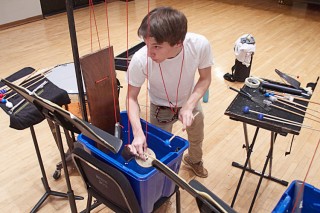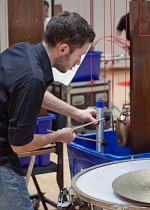Title

In Ondrej Adamek’s 2007 work Fishbones, some of the instruments—including the ones in these photos—are played while submersed in water. First-year Greg LaRosa plays a crotale.
(Photo by Jeffrey Cuyubamba)“Percussion music is revolution. Sound and rhythm have too long been submissive to the restrictions of nineteenth-century music. Today we are fighting for their emancipation.” —John Cage, Silence (1961)
Body
You may be surprised to learn that John Cage was one of percussion’s founding fathers. Sure, there was boom, crack, and crash thousands of years before there was Cage, but it took his soft-spoken vision to help the public expand its vision about what percussion is and what it could be.
So what is percussion? The answer is more difficult than one would think. Most other instruments have a “finite-ness” to them. No offense to my colleagues, but it’s fairly simple for, say, a clarinetist to choose what to hold in her senior picture and for anyone to recognize her as a clarinetist. Percussion is different. As a percussionist, many of the instruments I could be photographed with might inspire Grandma to ask if I had suddenly become a carpenter or blacksmith. Marimbas, xylophones, chimes, and bass drums are foundational to the role of a percussionist; however, there are thousands of other instruments that speak to percussion’s essence: a gong from Burma, a tambourine from Egypt, a few carefully chosen flower pots, trees of loose keys, tuned rice bowls, slats of resonant wood, oxygen tanks cut to pitch, tin cans, tennis balls—the list goes on.
Frankly, we percussionists have a problem: we hoard instruments, but the truth is that we are actually hoarding sounds—and that’s why composers love us.
Les Percussions de Strasbourg, a six-person group that celebrated 50 years of performances, education, and composer collaborations in 2012, has been among the foremost collaborators with composers in terms of developing both percussion instruments and repertoire. On November 12, the greater New York community can witness Juilliard’s cadre of sound hoarders in action, directed by percussion department chair Daniel Druckman (Pre-College ’76; B.M. and M.M. ’80, percussion), as the Percussion Ensemble presents three works commissioned by this legendary sextet.
Though percussion ensembles existed before Les Percussions (the early works of George Antheil, Edgard Varèse, Henry Cowell, Lou Harrison and John Cage, among others, were performed by ensembles of percussionists), Les Percussions was among the first to establish a regular roster of trained percussionists with the goal of creating and developing a repertoire for its configuration. It all began with Félix Passerone, who was a professor of percussion at the Paris Conservatoire from 1947 to 1957. Passerone strove to bring percussion into the spotlight of Parisian society, and trained his students to do the same. He also saw potential outside Paris: “Go to Strasbourg,” he would tell his students, “because something grand is going to happen for percussion” (this quote comes from the liner notes to Les Percussions’ latest box-set release for Universal Music France, which is a fabulous resource for anyone interested in this historic group).
In the early 1960s, Pierre Boulez came to Strasbourg to conduct his work Le visage nuptial, which brought six Passerone students together, and Les Percussions de Strasbourg was founded. After forming, however, the group realized it had a problem: there were no pieces for it to play. Through Boulez’s support and guidance, they were able to make connections with major living composers within Europe and abroad.
The collaborations between Les Percussions and living composers created exponential development in both percussion ensemble repertoire and instruments. Among its greatest contributions is the sixxen: several U-shaped metal bars suspended in the arrangement of an enlarged piano keyboard. A complex and dense overtone series makes this resonant metal instrument capable of producing previously unheard percussive attacks and walls of harmony. This instrument was created through a collaboration of Les Percussions with composer Iannis Xenakis, who wrote two seminal works for the ensemble: Persephassa (1969) and Pléiades (1978). The instrument’s name is a combination of “six,” for six percussionists, and “xen,” for Xenakis. While this was one of the ensemble’s most important collaborations, the list of composers with whom it worked is essentially a list of influential 20th-century composers: Olivier Messiaen, Georges Aperghis, Franco Donatoni, Gérard Grisey, André Jolivet, François-Bernard Machê, Martin Matlon, Luigi Nono, Wolfgang Rihm, James Wood, Karlheinz Stockhausen, and Cage among them.
The November 12 concert features works which span the group’s history, and it will showcase sounds that are fully emancipated from 19th-century restrictions, as per Cage’s aforementioned dictum. The program will begin with Ondrej Adamek’s 2007 Fishbones. Adamek’s compositions exploit the gradients of pitch that lie between the notes on the keyboard. With this piece, he reached back to the Cage’s discovery of the water gong to bring the usually fixed pitches of planks of wood, plastic woodblocks, cowbells (almglocken), crotales, and metal tubes to life by submerging the instruments in water while striking them. Adamek’s employment of the six players with similar yet graduated collections of instruments allows the group to become an orchestra with a diverse harmonic spectrum and smooth portamento—an eerie and fluid sound that is unique to the voice of this young composer and is rarely heard in percussion compositions.
Cage believed that all sounds should be considered equal in the eyes of performers, composers, and audiences. Bleu Jusqu’au Blanc by Stefano Gervasoni begins with a driving introduction played on, yes, spoons. Ripping responses in guiros and woodblocks pave the way for buzzing alarm clocks with increasingly interruptive moo-calls (the cylindrical toys that produce a “moo” sound when turned upside down). Listening to how these sounds crash into each other will chauffeur the listener through a segmented formal structure in which blocks of texture collide. After intermission, Philippe Manoury’s Le Livre des Claviers (“Book of Keyboards”) features the well-tempered tuning of the marimba and vibraphone juxtaposed with and accented by the complex overtones of Thai gongs and the alternate sound universe of the sixxen. Manoury’s emphasis on the resonance of these instruments can be heard in every measure of this six-movement work.
Though this concert features only three of the hundreds of works written for Les Percussions de Strasbourg, it will serve as a glimpse into the percussionist’s world: a seemingly endless exploration of sound, density, invention, and exploration.





